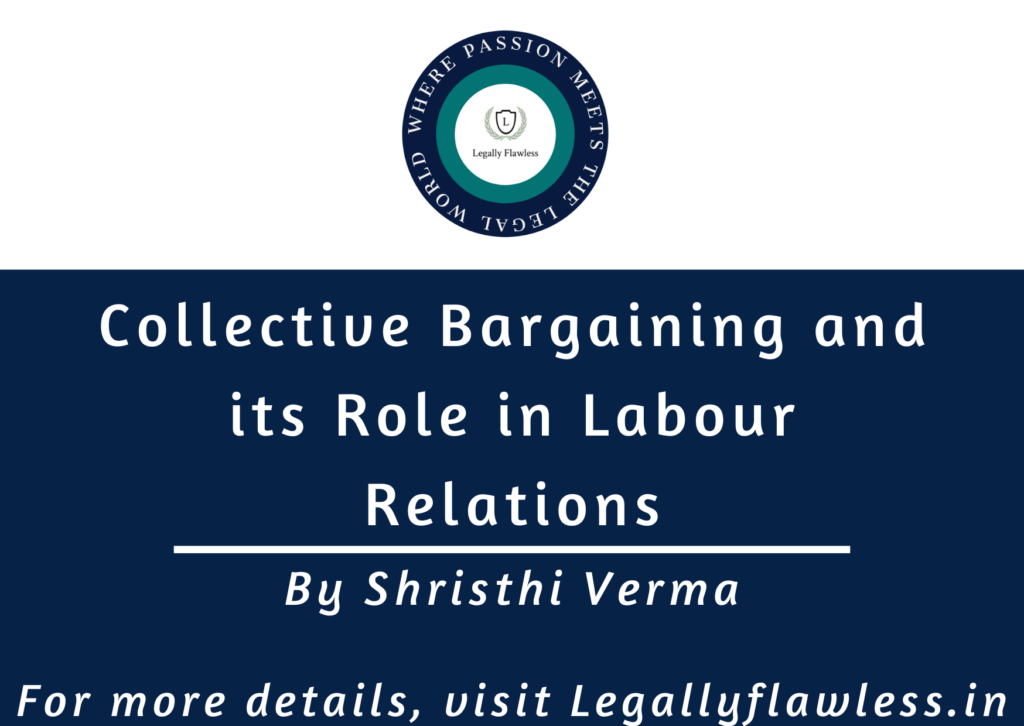
Collective bargaining is a tool through which the dispute between labour and employer can be resolved. Since if a dispute is settled through a court or tribunal, it will take a lot of time and money to resolve a dispute which could be resolved through negotiations between employers and employees. It has become more convenient to adjudicate industrial disputes by collective bargaining. Overall, Collective Bargaining is a process through which the employer and the employees resolve disputes through harmonious discussions and settlements.
ILO’s 1998 Declaration on Fundamental Principles and Rights at Work reaffirms collective bargaining as a fundamental right of workers. In Article 2 of the Collective Bargaining Convention 1981, collective bargaining is defined as “collective bargaining extends to all negotiations which take place between an employer, a group of employers or one or more employers’ organizations, on the one hand, and one or more workers’ organizations, on the other, for
(a) determining working conditions and terms of employment; and/or
(b) regulating relations between employers and workers; and/or
While the Trade unions and labour orgainsation represent the employees/workers. In order to ensure fair wages and working conditions for workers, employees, and their organizations and unions work together. Sound labour relations can be achieved through collective bargaining, which provides a channel for negotiating and settling issues like working time, training, occupational health treatment, safety, and equality. The main objective of the collective bargaining agreement is that employment is to arrive at collectively regulated terms and conditions. It smoothens the mechanism of the workers being another pillar of industrial democracy, to take decisions, share the responsibility of the work and have authority in the workplace. This method of settling and resolving disputes helps in protecting the workers from authoritative employees and promotes equality and fair treatment in the workplace. It discourages the toxic work culture and provides the opportunity for the employees to demand reasonable expectations from the employer.
Collective bargaining creates a sense of duty in the employers to give recognition to labour communities, and Trade Unions and to have a good relationship with the labour organizations. While the employees should not have any undue influence on the company to accept their demands and should have demands that sync with the economic condition of the company. Collective Bargaining, therefore, encourages the employees to be a part of a group of Trade Unions or labour organizations, that have a collective goal and reasonable demands that can be enforceable by the employers. It creates a sense of duty among employees and employers and gives them rights. Yet, collective bargaining can also be a hindrance such as the unionised employees and the bosses negotiate, it is a drawn-out, difficult process. Both parties must take time off from work because it takes a lot of time.
The existence of several trade unions in India is another problem that prevents this procedure from working well. Sometimes, negotiation for better working conditions is hampered by interunion rivalry. Most political parties support or are affiliated with labour unions. Frequently, the party’s choice is what affects the demands of the union. It is impossible to tell which union represents the workers. Another reason is that there will always remain an inequality between employers and employees which will impact who will have more bargaining power among the parties. It was noted by the Supreme Court of India that “collective bargaining is a method by which employment and wage problems are resolved by harmony rather than by coercion” in Karol Leather Karamchari Sangthan vs Liberty Footwear Company.
The Renowned DABUS Case: Revisiting To Seek Imperative Legal Clarity
While Collective Bargaining has both advantages and disadvantages, it is still an option for the parties to adopt to resolve the dispute. Collective bargaining can be a long process as it includes the formation of a trade union or labour communities, a charter of demands, and negotiation. If the dispute is not settled through negotiations, then the Union can go to strike and after which the dispute can be resolved through conciliation.
Collective Bargaining gained its legal authority, although it still has not received its legal recognition and rather must be interpreted through precedents and judgments. In the Industrial Disputes Act, of 1947, Section 18 provides that an employer and his employees can reach an agreement in place of conciliation that will bind them to any settlement other than a conciliation. Thus, it not directly but indirectly recognizes collective bargaining as the dispute-resolving mechanism. While the Trade Unions Act, of 1926 does not have a section for collective bargaining but in the case of D.N. Mukherjee vs P.R. Mukherjee, it was observed that the increasing importance of capital and labour, these organizations have been created that derives its acknowledgment from the theory that the unity is strength and collective bargaining is the result of that. While in the Constitution of India, Article 19 gives the power that citizens can freely form the association including trade union, which results that trade union also have the right to collective demand from employers. Article 43A provides the guideline for the state to make laws that encourage workers to take part in management.
Recently, there have been several new labour codes introduced by the legislative authority like Industrial Relation Code, 2020, etc. which replace Collective Bargaining with “Individual Settlements” that provides dispute to be settled individually. This is against the concept of collective bargaining and since India has not ratified the Collective Bargaining Convention, there is no outward law for the collective binding. Individual settlements are in conflict with the ILO Convention on tripartite consultation. Even the courts have held the individual settlements to be against the nature of the Industrial Disputes Act, of 1947, and recognize the Trade Union.
In Hindustan Lever v. Hindustan Lever Employees Union, the Bombay High Court held “individual settlements” as inconsistent with not only the concept of collective bargaining but the very basis of the Industrial Disputes Act, of 1947, itself. While in Central Inland Water Transportation vs Brojo Nath, Justice Dinsha Priosha Madon said that Trade Unions play a central role through collective bargaining in the unequal relationship, where workers are at risk of unemployment when the company is basically a large corporation.
In conclusion, collective bargaining is an important tool for dispute resolution between the employer and employee. Collective bargaining has a very limited scope in these statutes, and there is a need for recognition of it in the legal provisions of labour law. Even in the new code of 2020, the scope of collective bargaining is disappearing but is being kept in spirit through precedents. But this is not enough, the legislation needs to recognize the power of collective bargaining in regard to providing the rights to the employees and employers and also forming obligations to their duties.
This article is authored by Shristhi Verma, third year student at Institute of Law Nirma University, Ahmedabad
References:
- https://blog.ipleaders.in/all-about-a-collective-bargaining-agreement-in-india/
- https://legalserviceindia.com/legal/article-8300-collective-bargaining.html
- https://theleaflet.in/new-labour-codes-undo-the-law-on-workers-rights-and-collective-bargaining/
- https://www.ilo.org/global/topics/collective-bargaining-labour-relations/lang–en/index.htm


